Muscle strength testing
1/18
There's no tags or description
Looks like no tags are added yet.
Name | Mastery | Learn | Test | Matching | Spaced |
|---|
No study sessions yet.
19 Terms
Muscle strength definition
The ability of contractile tissue to produce tension and a resultant force according to the demands placed on that muscle.
Causes of muscle weakness
After trauma (e.g. Muscle strain, bone fractures)
In presence of disease (e.g. cancer, neurological diseases)
After surgery (e.g. surgery to repair soft tissue or fractured/broken bones)
In presence of pain
After disuse, disuse leads to muscular atrophy (muscle wasting- changes in muscle bulk/size; strength and mobility)
Indications for physiotherapists to measure muscle strength
To measure (and record) muscle weakness
To monitor the success of a physiotherapeutic intervention
To guide the progression of rehabilitation
What is MMT (manual muscle testing)
MMT is a non-invasive assessment method to evaluate neuromusculoskeletal integrity and muscle strength
Characteristics of MMT
An MMT is a manual form of muscle strength testing which does not require any additional equipment.
This is the standard way of assessing muscle strength in the absence of specialised equipment and the method students use in the clinical setting.
Manual muscle testing is a qualitative measure.
Skeletal muscle contractions
Isotonic contractions = maintain constant tension in the muscle as the muscle changes length.
Isotonic muscle contractions can be either concentric or eccentric.
Eccentric Contractions = An eccentric contraction results in the elongation (lengthening) of a muscle while the muscle is still generating force. An eccentric contraction results in the elongation (lengthening) of a muscle while the muscle is still generating force; in effect, resistance is greater than force generated.
for example, a voluntary eccentric contraction would be the controlled lowering of the heavy weight raised during the above concentric contraction.
Concentric Contractions
A type of muscle contraction in which the muscles shorten while generating force, overcoming resistance.
For example, when lifting a heavy weight, a concentric contraction of the biceps would cause the arm to bend at the elbow, lifting the weight towards the shoulder. Cross-bridge cycling occurs, shortening the sarcomere, muscle fibre, and muscle.
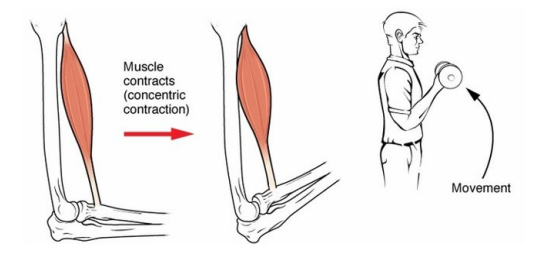
Eccentric Contractions
Eccentric Contractions = An eccentric contraction results in the elongation (lengthening) of a muscle while the muscle is still generating force. An eccentric contraction results in the elongation (lengthening) of a muscle while the muscle is still generating force; in effect, resistance is greater than force generated.
for example, a voluntary eccentric contraction would be the controlled lowering of the heavy weight raised during the above concentric contraction.
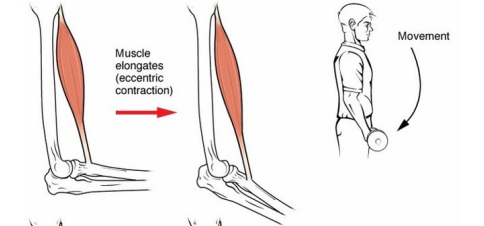
Isometric Contractions
Isometric contractions generate force without changing the length of the muscle, common in the muscles of the hand and forearm responsible for grip.
Using the above example, the muscle contraction required to grip but not move a heavy object prior to lifting would be isometric.
Isometric contractions are frequently used to maintain posture.
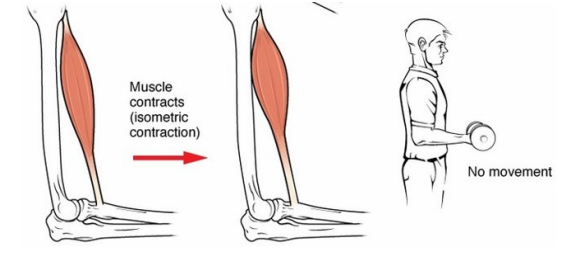
Ranges of muscle work (muscle excersion)
Inner range = shortest length a muscle can be at its point of maximum contraction. It's the position where the muscle's fibres are most shortened from the midpoint.
Outer range = This is the longest length a muscle can be stretched to. It's the position where the muscle fibres are most lengthened from the midpoint.
Middle Range = This is the position between midway between the inner and outer ranges.
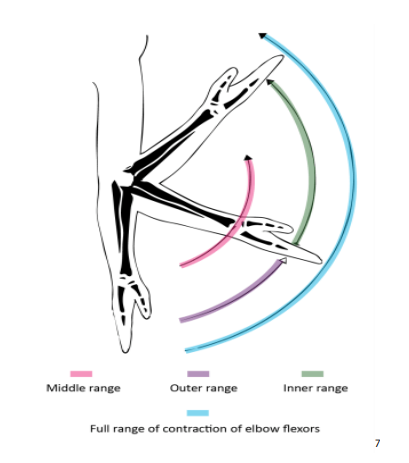
Clinical significances of ranges of muscle work
crucial in physiotherapy and rehabilitation. It helps
assesses the range of motion of a joint, identifying muscle imbalances, and designing exercises to improve strength and flexibility.
MRC Grading Scale
MUSCLE ACTIVATION
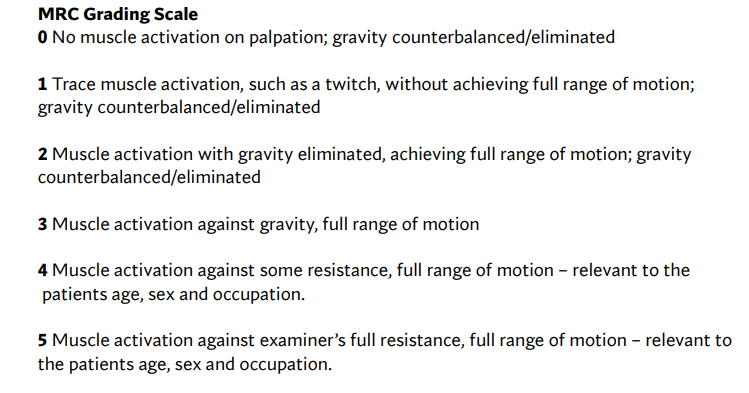
Deconstructing the MRC muscle grading scale (THE MUSCLE)
The muscle refers to a muscle or group of muscles being tested for its strength. The choice of muscle to be tested is dependent upon the physiotherapists assessment of the patient’s clinical picture/presentation (the subjective description of a patient’s symptoms identified in the subjective evaluation.)
Resistance
Resistance refers to the examiner or physiotherapist, providing manual resistance, with their hands as to counteract the patient’s movement while testing grades 4 and 5. The physiotherapist adds a gradual resistance force, either some (moderate) or maximal as the patient performs the movement.
Range of motion
refers to the active ROM that the patient can reach based on their will as a muscle produces tension
Limitations of the MRC grading scale
There may be individual variation in reporting.
Only assesses muscles contracting in a concentric manner.
The scale may not be applicable in all patient populations.
Contraindications to measuring muscle strength
Contraindication = A contraindication is a situation, symptom, or condition that makes a particular treatment or procedure unsuitable or inadvisable for a person due to the potential for harm.
Possible contraindications could be:
When the test may disrupt the healing process
Cause further injury
Exacerbate or worsen a patient’s condition
Conditions where muscle strength assessments include but are not limited to the following:
Unhealed/unstable fracture
Dislocation or unstable joint
Situations where active range of motion or resistance work are contraindicated (e.g. postoperative protocols etc.)
If pain limits participation
Severe inflammation
Severe osteoporosis
Severe cardiac disease
Severe respiratory disease
Haemophilia (bleeding disorder)
Decreased cognitive ability (difficulty understanding and following instructions)
Precautions to measuring muscle length
History of cardiac problems.
Where fatigue may worsen a patient’s condition. Signs of fatigue may include: muscular spasm, muscle tremors, tiredness, slow response.
Certain surgical procedures.
The presence of pain can inhibit muscle contraction affecting the accuracy of results for muscle strength tests.
Patients using the valsalva manoevre (breath holding) during the test. Breath holding affects pressures in the blood vessels in chest and abdominal cavity putting strain on the heart.
Proceed with caution in cases of inflammation or acute inflammatory neuromuscular disease
Dynanometer
it is a small device that fits in the examiners hand is placed at precise locations on a subjects limb to assess the force generated by various muscles or groups of muscles